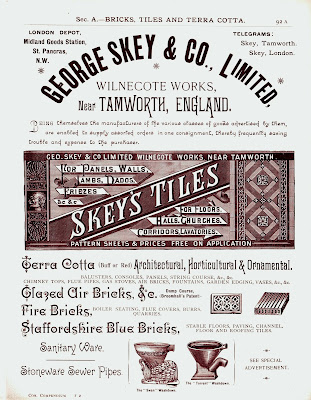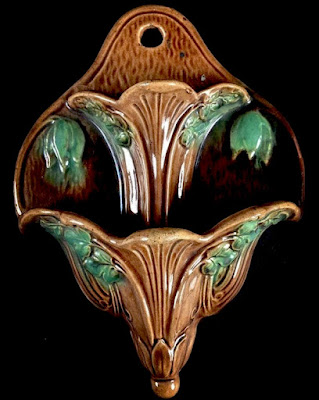Born in 1819 into a Quaker family, George Skey was an affluent mine owner who operated coal mines at Wilnecoate, Tamworth. Upon discovering substantial deposits of clay on his property Skey decided to enter the pottery business.
His pottery works, George Skey & Company Ltd., was founded in 1859 but didn't begin production until 1862 producing terra-cotta utilitarian wares used in construction as well as stoves, terra cotta sewage pipes, tiles, chimneys, bottles, crocks and glazed brick. He then began potting conservatory items.
By 1864 Skey expanded his company to encompass the production of decorative earthenware: fountains, vases, tazzas, brackets, pedestals, flower vases, mignonette boxes, fern stands, tiles and garden seats. He also made lined cane ware game dishes and began the production of porcelain items for construction.
Majolica was introduced at the Wilnecoate Works in the 1860s under the brand name Rustic Ware. Designed to imitate wood, the company used a limited palette of color glazes over an ochre earthenware body. The majority of items made by the company were garden items, but soon the company expanded to table and desk items as well as porcelain. In The Ceramic Art of Great Britain by Llewelyn Frederick William Jewitt (1878) the ware was discussed thus:
"In "Rustic ware," vases, garden-seats, flower-pots, brackets, fern-stands, and an infinite variety of beautiful articles are made. This "Rustic ware" is a fine buff coloured terra-cotta, glazed with a rich brown glaze, and sometimes heightened with a green tinge, just sufficient to give it a remarkably pleasing effect. The modelling (sic) of some of these goods is highly artistic."






















































At Tamworth Castle Bowls Club we have a George Skey lion statue which measures four and a half feet,we would like to know the history of it .
ReplyDeleteSounds intriguing! If you ever have a chance to snap a photo of it please send it to me. My email address is in my profile.
Delete